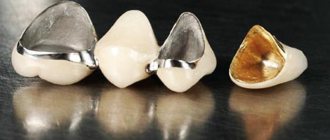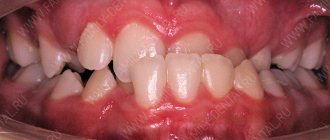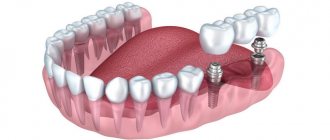Types of crowns for implants
What kind of crowns are placed on implants? Like regular dentures, implant-supported dental crowns come in a variety of types depending on the material. Today, the most popular materials used in the manufacture of crowns on implants are ceramics and metal-ceramics. Their main difference, as the name suggests, is the presence or absence of a metal frame in the design. Recently, it has become popular, for example, to install zirconium crowns on implants - all-zirconium or ceramic restoration structures made on a zirconium frame.
- Ceramic
Dentures made of ceramics are usually recommended to be installed in the area of the front teeth. Such structures are highly biocompatible, which means they do not have any negative effects on the soft tissues of the oral cavity. Plus, they look exactly like natural teeth. Ceramic crowns are more transparent, so in this case an abutment will be made of ceramic or zirconium. - Zirconium
Implant Crowns made from this modern material are most in demand by specialists today. The secret of their popularity is simple: they combine good aesthetic qualities and high strength. - Metal-ceramic
Metal-ceramic is perhaps the most common material used for the manufacture of dentures. Metal-ceramic crowns on implants for chewing teeth are inexpensive and reliable. They usually require a metal abutment.
What is an implant
Implants are titanium roots that are implanted into the bone tissue of the jaw. An artificial crown is attached on top of them, which is visually indistinguishable from a natural tooth. The metal root takes on all the functions of the removed unit, avoids gum atrophy, maintains diction, and ensures uniform load while chewing solid food.
The structure installed on the implant consists of three parts:
- a metal base implanted into the bone tissue of the jaw in place of the missing unit;
- abutment - intermediate link, periosteal element;
- dental crown.
Since there is an abutment between the prosthesis and the pin, the crown is most often made from one material, that is, the use of a metal frame is not necessary here.
What is the best crown to put on an implant?
The answer to this question depends on the area being implanted and your budget. If we are talking about chewing teeth and the patient does not want to overpay, then the doctor will most likely recommend metal ceramics. Zirconium crowns for chewing teeth will undoubtedly be the best option. However, it is also more expensive. If prosthetics takes place in the so-called smile zone, then it is better to place a crown on a ceramic implant. She will look not only beautiful, but also absolutely natural.
Metal-ceramic crown.
They are a metal frame covered with ceramic mass on top. Can be installed on any teeth. There are some aesthetic disadvantages in the area of the anterior teeth. If the gums are naturally thin, the metal edge of the crown will be visible through the gums. If the enamel of your own teeth, located together with the tooth on the implant, is highly translucent, then the metal-ceramic crown will stand out against this background. On chewing teeth, such crowns perform their function perfectly.
A titanium abutment is installed under the metal-ceramic crown. There is no need for zirconium. Some dentists may offer a cobalt-chromium alloy abutment. It is up to the patient to decide whether or not to agree to this abutment option, but they are extremely unreliable and there is a risk of such an abutment breaking. It cannot be replaced, so it is removed along with the implant.
Installing a crown on an implant
Installing a crown on an implant involves putting a specially machined crown on an abutment that connects it to the implant - an artificial root, while crowns for traditional prosthetics are made from casts of ground natural teeth and installed on previously prepared teeth.
How long does it take to place crowns on implants? It all depends on the clinical picture. If immediately after installation the implant is stable and there are no indications for delayed prosthetics, then the implantologist places a crown on the implant immediately. In the area of the chewing teeth, which are not visible when smiling, most likely, a crown will be placed several months after the final implantation.
Installation steps
- After installation, an abutment is placed on the dental implant. Essentially, it replaces the tooth stump that is left after preparing the tooth before installing a conventional crown.
- When the abutment is installed, the doctor takes an impression to subsequently make a permanent crown for the implant.
- The final stage of installing a dental crown on an implant is fixing the prosthesis to the abutment.
Fixation of the crown on the implant: screw and cement
There are two ways in which you can place a crown on an implant - screw and cement. Screw-retained implant crowns involve drilling a hole in a prefabricated crown, which is later sealed. A screw is inserted through it, passes through the crown and is screwed into the abutment. All this happens outside the patient's mouth. When the crown and abutment are securely connected, the latter is secured in a special hole in the implant. Cement fixation of a crown on an implant is similar to the installation of a conventional crown: it is glued to the abutment using special cement - a composite material, while the abutment is already securely fixed in the implant, and the installation procedure takes place directly in the patient’s oral cavity.
All of the above applies to permanent crowns - those that are installed some time after implantation, when the first period of engraftment passes. But in most cases, implantation involves the possibility of instantly loading the implant with a temporary crown.
Installation process
After the implant has taken root (this usually takes several months), you can proceed to installing a crown made from an individual impression. During this procedure, the dentist places the prosthesis on the abutment and connects it to the implant.
Fixation of the crown can be cement or screw. In the first case, the elements are connected to each other using a special adhesive composition. All manipulations take place in the patient’s oral cavity.
With screw fastening things are a little more complicated. First, the doctor makes a small hole in the crown. A screw is inserted through it, passing through the crown, and the abutment is screwed in. All of this occurs outside the client's mouth. When all the parts are firmly connected, the previously made hole is sealed without a trace.
With both installation methods, the patient does not feel any pain, since the gums have completely healed. Therefore, anesthesia is not required at this stage of implantation treatment.
Why are temporary crowns needed for implants?
Temporary crowns on implants are installed primarily for aesthetic reasons, so that the patient does not walk around with a “hole” in the mouth for the entire healing period. This is especially true for prosthetics in the smile area. In addition, the temporary crown, although not always fully functional, is still involved in speech and chewing. It is distinguished from a permanent crown by the material of production - light plastic, and therefore also by cost and weight. These parameters are important, since spending a lot of money on a temporary crown, which is not needed for a long period of time, is inappropriate, and loading a newly installed implant with a crown of full weight is dangerous. At the same time, externally, temporary crowns are practically indistinguishable from permanent ones, and therefore from natural teeth, their color is matched to the shade of the enamel of the surrounding teeth, all this allows you to hide the prosthetic process from prying eyes.
Metal-free crowns
Such structures do not contain metal elements and consist entirely of ceramic mass or zirconium dioxide. Zirconium crowns have an advantage due to many positive properties:
- A combination of aesthetics and durability.
- There is no metal, so it can be used on the front teeth.
- There is no negative effect on the mucous membrane, the material is safe.
- The color and shape of the crowns are maintained throughout the wearing period.
- Artificial teeth are indistinguishable from natural ones.
- The service life of the product exceeds 20 years with proper care.
The specialists of “Dentistry at Amazing Prices” remind you that in addition to zirconium lined with ceramics, we work with all-zirconium crowns, which, being more affordable, are ideal for prosthetics of chewing teeth.
PROMOTION
Place a Quadrotti denture
30,000 rub.
Which is better, a crown or an implant?
When asking a similar question, patients most often mean the installation of dentures based on their own teeth and implantation. What is the difference between a regular crown and an implant? In order to install a conventional bridge, it is necessary to grind down the healthy teeth adjacent to the defect, which will begin to decay over time and the bridge will have to be lengthened. This cannot happen with an implant. Its installation does not affect the “neighbors” in any way, and its service life is not limited. Only the crown will have to be changed. The service life of crowns on implants is about 10 - 12 years, and in many cases reaches 15 years, while with traditional prosthetics, the crown must be changed every 5 - 7 years, grinding the teeth in a new way.
What is an abutment?
An abutment is an adapter head that is screwed to the implant, and on top of which, in turn, a crown (or any other prosthetic structure) is placed. Each implant system has its own set of various standard abutments.
The greater the choice of different configurations and sizes of abutments, the easier it is for the orthopedic surgeon to solve any clinical situation. Expensive popular systems have a wide range of these important spare parts, as they say, for all occasions. And so they are preferable. Therefore, the doctor often makes the choice of an implant system based on what possibilities for prosthetics are provided by a particular manufacturer. Equally important is the degree of accuracy and reliability of the connection between the abutment and the implant.
It's like a construction set, the parts of which must fit perfectly together. The service life of the entire structure largely depends on this. And here, as a rule, the simpler and more budget-friendly the system, the more flaws and design inconsistencies it encounters.











